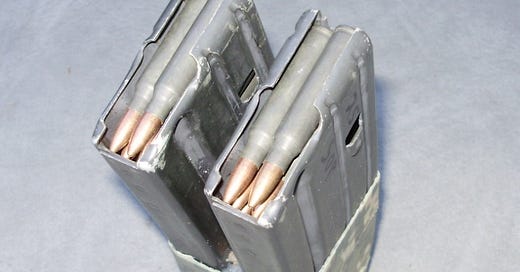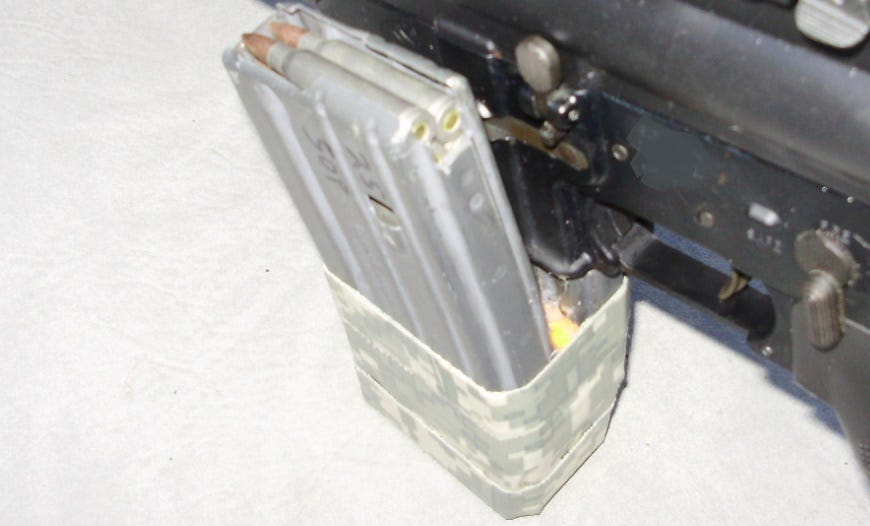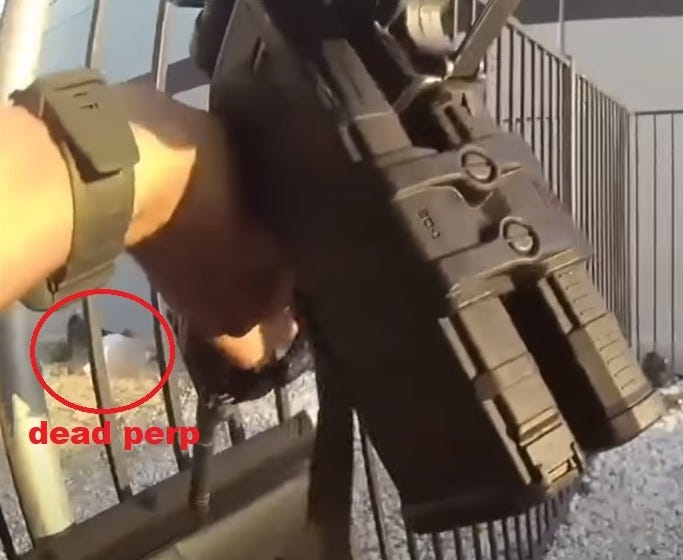[I wrote this for the old Western Rifle Shooters Association back in 2010. It’s part of The Bracken Collection: Essays and Short Fiction.]
Who wouldn’t want a sixty-round magazine for their trusty AR, one that fits in roughly the same space as a standard thirty-round mag?
Nobody I know.
Problem is, such a magazine doesn’t exist. But there is a way to link two thirty-round mags so that the switch from the thirtieth to the thirty-first cartridge is extremely fast. Much faster than any switch to a second magazine kept in a pouch on your body.
Twice as fast.
We were doing this in the SEAL Teams decades ago. Today, companies make magazine duplexing gadgets that you can buy, but don’t bother with them. The old way is better, because the bottom of the homemade double mag is narrower and easier to grab and manipulate. This is because the two mags are in a narrow “V” shape. They are not parallel, as with the store-bought duplexing gadgets. You will understand why this matters when you do these speed changes in practice. The bottom of your duplexed mag is your handle during the switch.
So here’s how you make it.
Take two good thirty-round AR mags that you know work well. Then take an ordinary wood pencil, and cut off a two-inch piece, square at both ends. Place it cross-wise three inches up from the bottom of one magazine. Take green military “hundred-mile-an-hour” tape, duct tape, camo tape or green electricians’ tape, and bind the two mags tightly together, starting at their bottoms so they are touching.
Tape them all the way up to the pencil location. To make an even more solid mount, fill the gap below the pencil with silicone rubber before you tape them up. The pencil placement three inches up from the bottom is important. The slot between the two mags will just clear the magazine well of your rifle, and it will allow enough space for the open dust cover.
Now, what about taping two mags end-to-end, with cartridges at top and bottom? Only in grade-Z action movies. When you hit the ground, you will be pounding dirt into the open magazine at the bottom, and maybe even denting or deforming the critical feed lips. And besides, doing it the end-to-end way makes a double magazine much longer than it needs to be. This end-to-end method makes a little more sense with very curvy Kalashnikov magazines. Not every rifle’s construction permits the use of side-by-side duplexed mags. They are perfectly suited to ARs, however.
Now you are at the range, and you have your duplexed AR mags ready to try. Load one so that the right-side mag is in the well, and the spare mag is fitting just along the left side of your rifle. This twice-as-heavy double mag will not fall out accidentally, or wear out the mag catch. It will drop free completely normally with the usual push of the mag release button. If you are doing a tactical reload before running dry, or if you do actually run out of cartridges, you will do everything the same as you did before, but faster.
Quite a lot faster.
Whether you are initiating an ambush or if you are on the receiving end, the first reload will very likely be the most critical of any engagement. If you can sustain rapid fire when the other guy’s weapon runs dry, your odds of seeing tomorrow will go up and his will go down. If you can cut your first reload time in half, it might make all of the difference.
Even having the ability to bluff greater firepower on your side than you actually possess is a good thing. You can do this simply by touching off up to sixty incredibly fast shots when breaking contact—a one-man Australian peel. Based on your rate of fire the opposition may mistake you for three or four shooters, and pause to think things over from behind cover while you slip away.
This brings to my mind the old SEAL Team adage about the critical importance of dominating all sides of the following triangle, namely: “surprise, firepower, and violence of action.” (Law enforcement has tamed this down to to the more PC “speed of action.”) A duplexed mag in your rifle gives you more effective firepower, which is always a good thing — especially at the critical beginning of a firefight or ambush. If you’re too slow on that first mag change, you might not need a second magazine.
Ever.
Here’s a hypothetical example; your mileage may vary, but the principle will hold.
How many rounds can you fire in three seconds? Really light up that trigger.
That is how many rounds might be fired at you by one bad guy during the three seconds it may take you to fumble a mag out of its pouch and shove it up into the well. Why not cut that delay in half on your first reload?
You won’t always have your battle rattle handy, much less already on your body, when trouble comes calling. Goblins do not call ahead. Will you holler “time out” under incoming fire or while your front door is kicked in while you suit up like Robocop?
You might not live long enough to be ready to fight, depending on the immediacy of the danger. No, when jumped, you will grab what is most handy and get in the fight, now! Maybe just the rifle itself. So keep sixty rounds really handy, in your rifle.
Another nifty advantage to the V-shaped double magazine is that it will fit snugly over your belt. No time to throw on your high-speed tactical harness, web gear, plate carriers and all the rest? Shove a double mag over your street-clothes belt, bullets down. You already have a double mag in your rifle, right? Now head out of your door with 120 rounds ready to go on a moment’s notice. Be ready to dominate. Always!
Should you duplex all of your AR mags?
No way. Duplexed mags don’t fit easily in many standard pouches. Only two duplexed mags will fit into a standard military three-mag pouch, a clear disadvantage. But your first sixty rounds can and should be hanging from your rifle, ready to go. IMHO.
The big double magazine lives in your rifle when you go in harm’s way. It’s not a pouch queen. It doesn’t give one damn about pouches. (Dump bags it loves, if you have the time.)
One final point — there is the inevitable complaint that the open mag will be jammed with debris.
It won’t.
It’s up next to the receiver, and under your clear vision. You can see that the open mag is clean.
“Old Sarge” will say not to do this. “Old Sarge” also said that electro-optical sights would never cut it in real combat.
So why doesn’t everybody do this?
This is just my hunch (since I’ve been out of the tactical ops arena for so long), but I think that the “Big Army” and other large military formations find “one size fits all” SOPs to be easier for everyone to follow up and down the chain of command. Same in police departments, and these restrictive SOPs permeate the shooting world.
In the SEAL Teams, we didn’t suffer from this malady. We did whatever worked. And not even all SEALs liked this duplexed magazine trick.
But you might. So give it a try — it costs virtually nothing.
And on your next range outing with your AR, do some speed trials. Compare changing between duplexed mags to changing to a spare mag kept on your body in a pouch. If you find it useful, use this trick, and pass it on to your buddies. Otherwise, forget you read this piece, untape your duplexed magazines, and no harm done.
But for me — make mine sixty, attached to my rifle and ready to go.
(2019 note: Now that you probably have switched to polymer mags for your ARs, I’ll bet you have some old 30-round alloy mags lying around. Give it a try and duplex a pair, what do you have to lose?)
(2025 note: Some police departments are using factory-made magazine duplexers. See the body-cam photo below.)
“In Praise of Duplexed AR Magazines” is one of the 35 short and long fiction and non-fiction pieces in The Bracken Collection.
My books have over 9,000 Amazon reviews, with an average 4.7 out of 5 stars rating.










Matt such a magazine does exist. I own ooo 28 of them. The SureFire 60 is a single mag holding 60 rounds. As stated made by SureFire a well known company who produces many top notch items.
I always hated the idea of being out front when the dreaded mag change thing happens. Admittedly I’m surprised more folks aren’t running the SureFire 60, just makes sense. It’s no different then a 30 rounder other then the lower half is twice as wide to accommodated the 30 extra rounds.
I’ve owned these mags for more than ten years. Never an issue
Hope this helps in your search for quality kit.
Dirk Williams
I did this after reading your article on the WRSA website. It’s a great idea. I adapted it then and have a pair of the duplexed mags for all my rifles. I passed the idea on to family and friends I thought would be interested. Thank you for the books you write and the info you pass on.